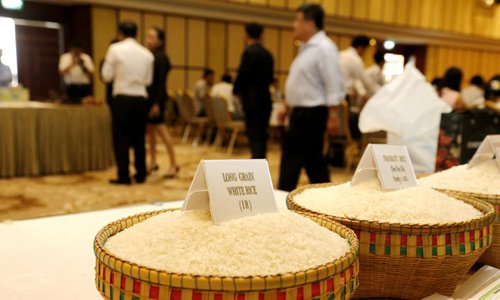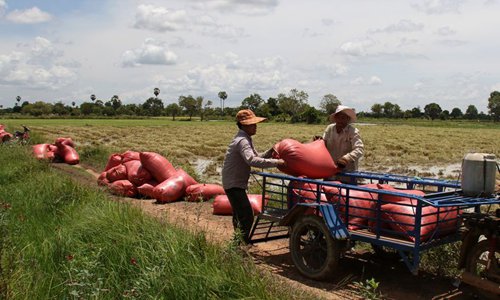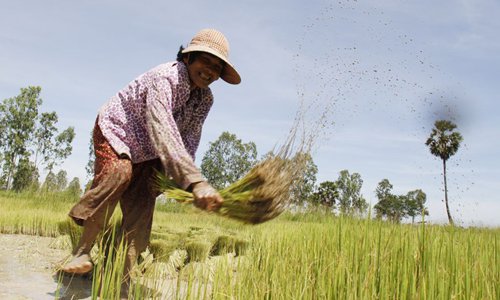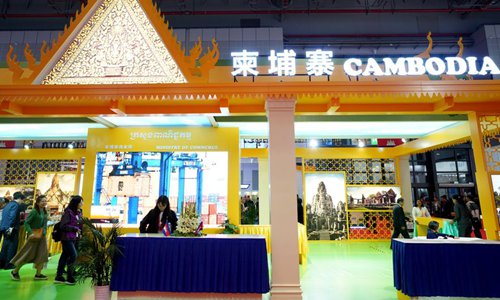HOME >> WORLD
Cambodia hopes to expand market for rice via upcoming China Int'l Import Expo
Source:Xinhua Published: 2019/10/21 13:49:23

Cambodian rice is displayed during a product fair in Phnom Penh, Cambodia on June 22, 2015. (Xinhua/Phearum)
"Chinese dishes and Cambodian rice are best match!" said Song Saran, president of the Cambodia Rice Federation, "I believe that Cambodian rice will become more and more popular in China."
In an interview with Xinhua on Friday, Saran said that Cambodia will grasp the opportunity of the second China International Import Expo (CIIE) in Shanghai to promote its best quality rice to the Chinese and international markets.
Thirteen Cambodian rice exporters will showcase their finest rice at the second edition of the CIIE, which is scheduled for Nov. 5-10 in Shanghai, said Saran, adding that Cambodian rice exporters hope to sign more contracts during the expo.
In his office, a variety of rice samples and awards of best rice winners are displayed on shelves. Saran said three varieties of Cambodian rice will be brought to exhibit at the event.
"The first one is Malys Angkor (jasmine rice). Malys Angkor aromatic rice is the world's best rice winner (in 2018)," he said, adding that the other two are fragrant rice and premium white rice.

Farmers load sacks of paddy rice onto the cart in Kandal province, Cambodia, Sept. 16, 2016. (Xinhua/Sovannara)
As about 80 percent of Cambodia's population is farmers, rice has been grown throughout the country, and almost 40 percent of the volume of milled rice produced in the country has been shipped to China.
Saran said the export of Cambodian rice to China has remarkably increased during the first nine months of 2019 after the federation took part in the first CIIE in last November.
The kingdom exported 157,793 tons of rice to China during the January-September period this year, up 44 percent over the same period last year, he said, adding that the export to China accounted for 39.6 percent of the country's total rice export.
China has become the top buyer of Cambodian rice. Saran was strongly confident that the volume will continue to grow in coming years. He said Cambodian rice has been popular in China for the last five years thanks to its good quality and delicious flavor.
"First, it's tasty; second, it's very tender and (has) a very good aroma," he said, emphasizing that Cambodian rice has been grown around the Tonle Sap Lake, where the soil is fertile and farmers do not use chemical fertilizers and insecticide, which makes consumers feel more safe and confident to consume Cambodian rice.
Kann Kunthy, vice president of Amru Rice (Cambodia), which will partake in the upcoming CIIE, said the company has contracted with farmers, providing them seeds and techniques in order to grow the best and chemical-free rice for the Chinese market.

A Cambodian farmer removes rice seedlings in Dangkor district on the outskirts of Phnom Penh, Cambodia, Aug. 20, 2014. (Xinhua/Sovannara)
In the factory on the western outskirts of Phnom Penh , as engines roared on Friday, workers had feverishly worked based on their duties and responsibilities. Some unloaded unprocessed rice from trucks and poured it into an intake hopper, where the rice would go through all processes and end up in packaging.
Then, the quality of the processed rice will be checked and certified by a team of Chinese experts from the CCIC (China Certification & Inspection Group) before being permitted to be uploaded into containers destined for China.
"When rice arrives at our factory here, we have our QC (Quality Controller) inspect again to make sure that we buy Grade A, we get Grade A," he said. "When it comes to packing, CCIC checks it again, just to make sure the rice is 100 percent Grade A, so we only ship the best rice to China."
Cheng Vuthy, a QC manager of the Amru Rice Reprocessing Factory, said quality and safety are the top priorities and that the factory always adheres to quality criteria required by clients.
"We work very hard to make sure we bring our best to Chinese consumers," he told Xinhua. "During the past years, Chinese market has been growing very fast and we are very happy to know our rice will be exhibited in Shanghai."
"This container behind me will be shipped to China soon, and we hope our rice can become more and more popular in China," he added.

The booth of Cambodia is seen at the first China International Import Expo (CIIE) in Shanghai, east China, Nov. 8, 2018. (Xinhua/Cheng Li)
Chen Qisheng, general manager of CCIC's Cambodian branch, told Xinhua that, the coming expo in Shanghai will be a golden chance for Cambodia to introduce its rice to more Chinese consumers.
"I've been working in Cambodia for two years. Cambodian rice is aromatic and glutinous. Cambodian farms are clean, and have no chemical pollution," Chen said, "that's why Cambodian rice is tasty and safe."
In addition to rice, China also imports banana, cassava and cashew-nuts from Cambodia. Chen said that CCIC has been working with Cambodian partners to export more kinds of agricultural products to China, including mango, dragon fruit, coconut and etc. "With the help from Chinese partners and huge demand of Chinese consumers, Cambodian agricultural sector is going to boom."
Posted in: CENTRAL & SOUTH ASIA